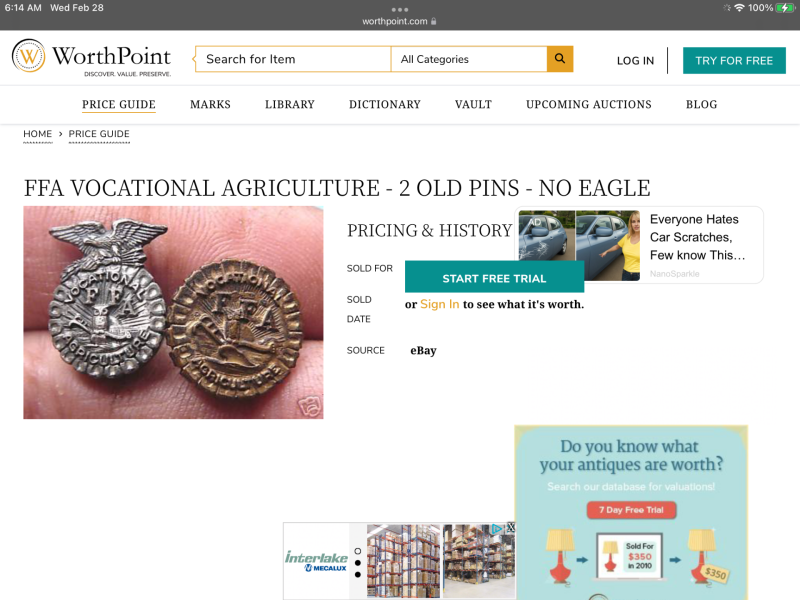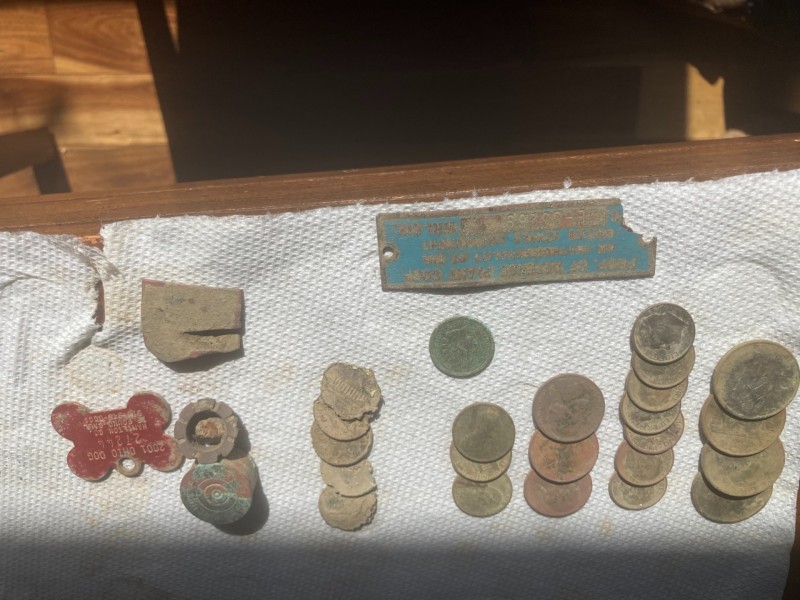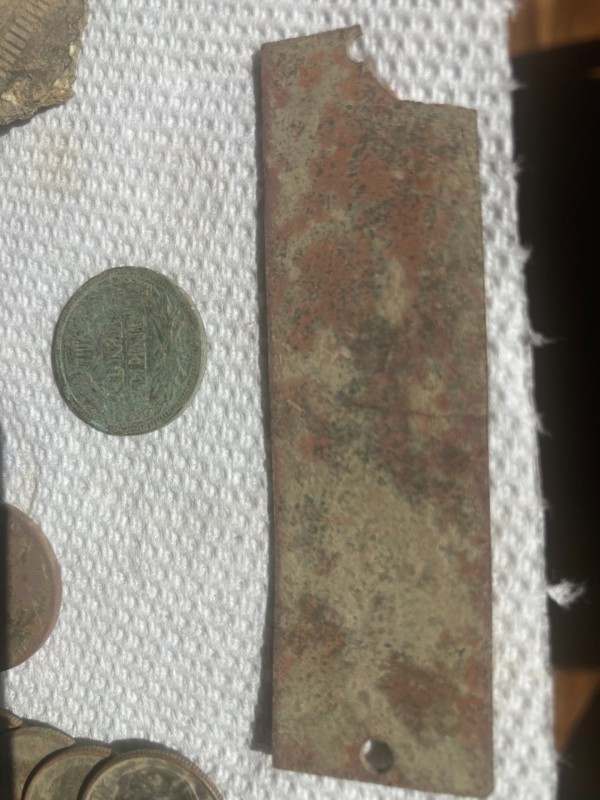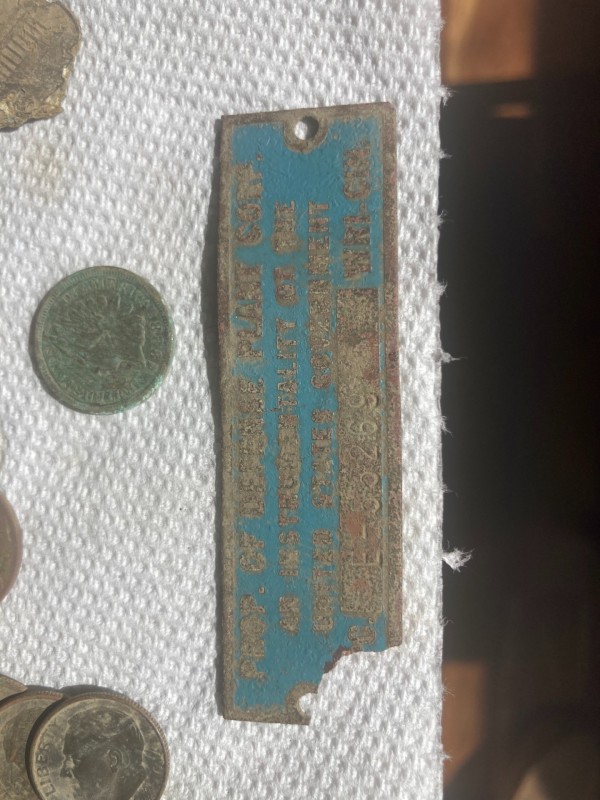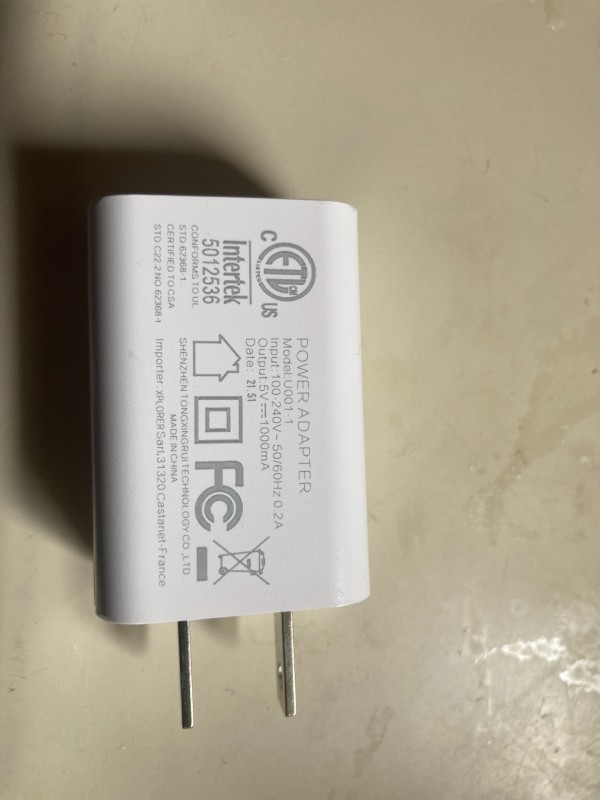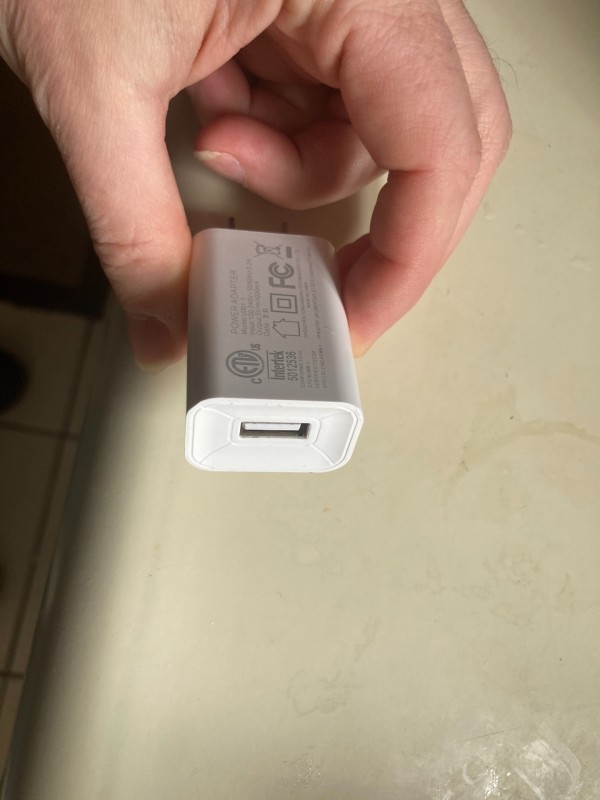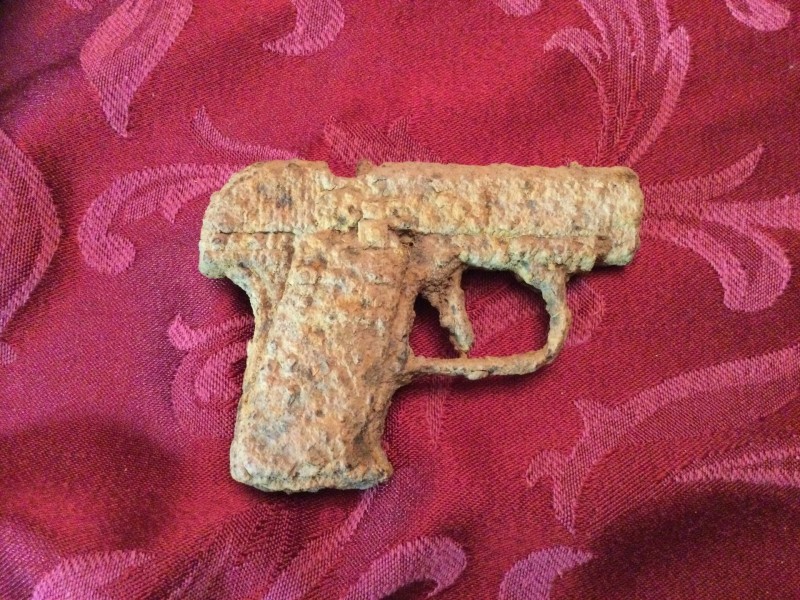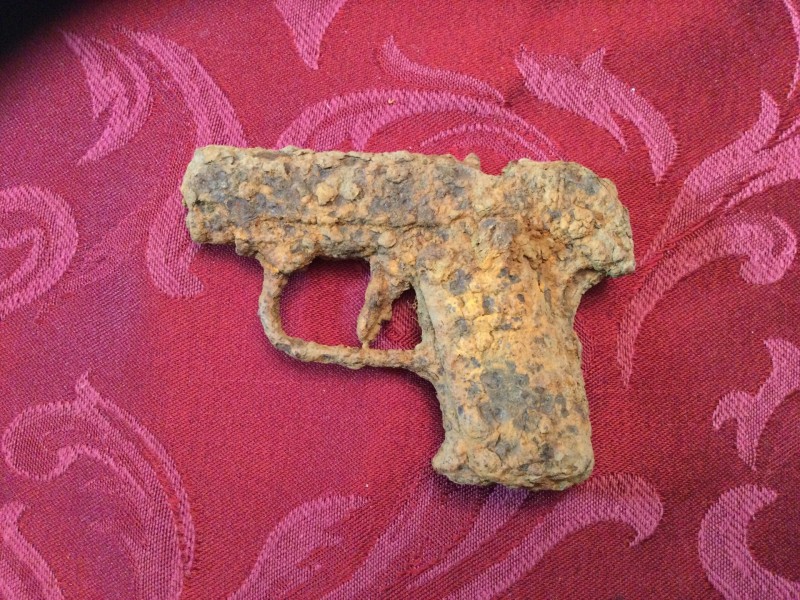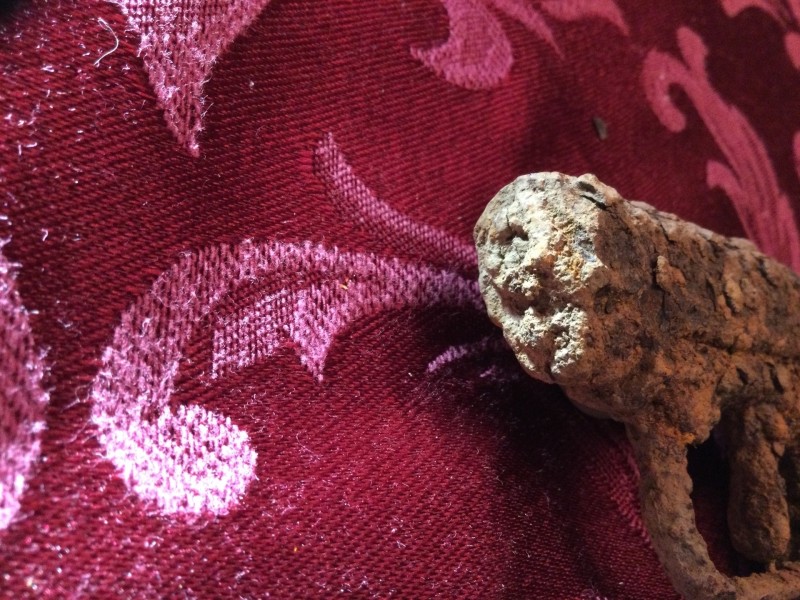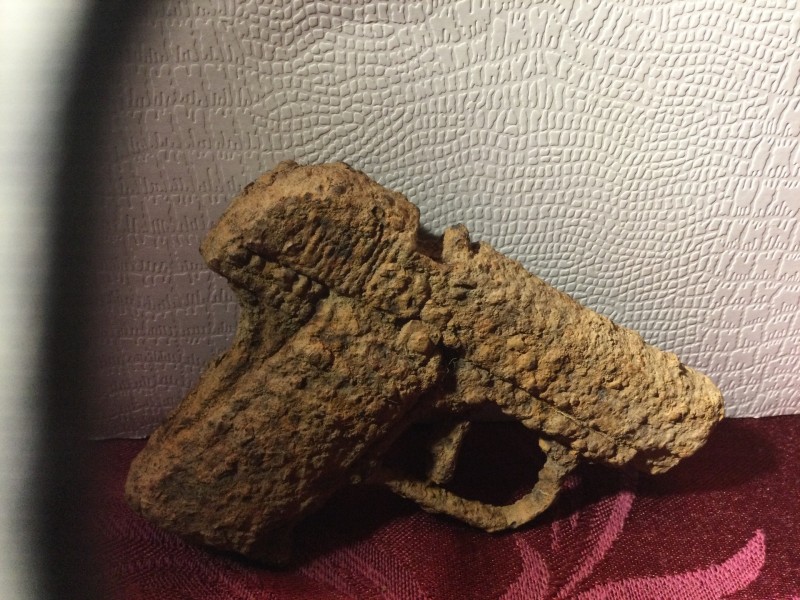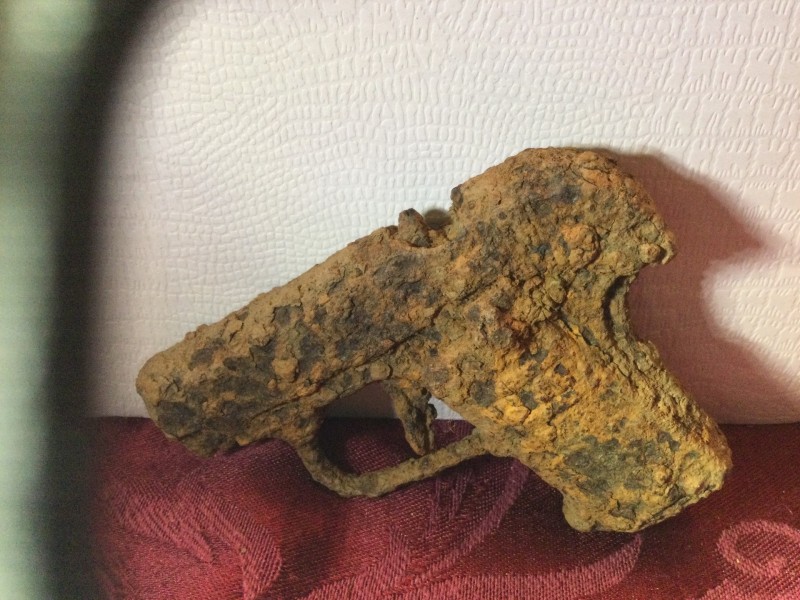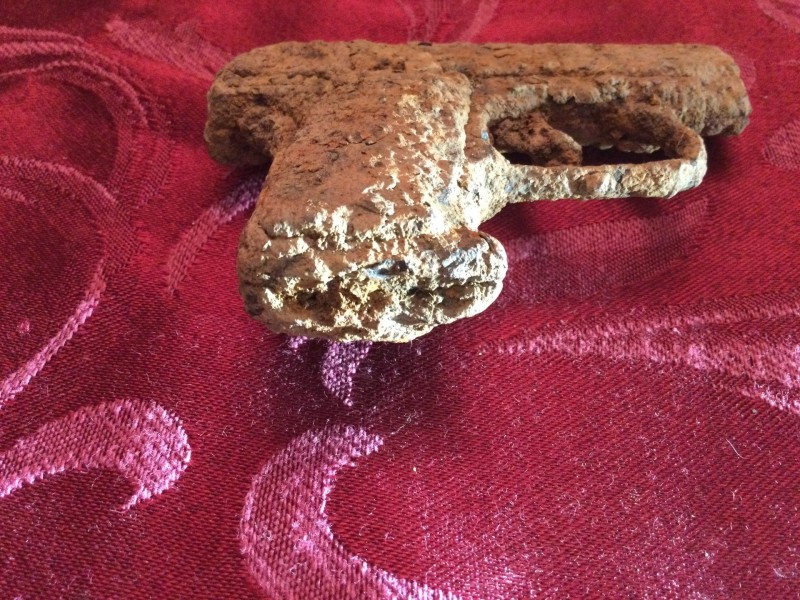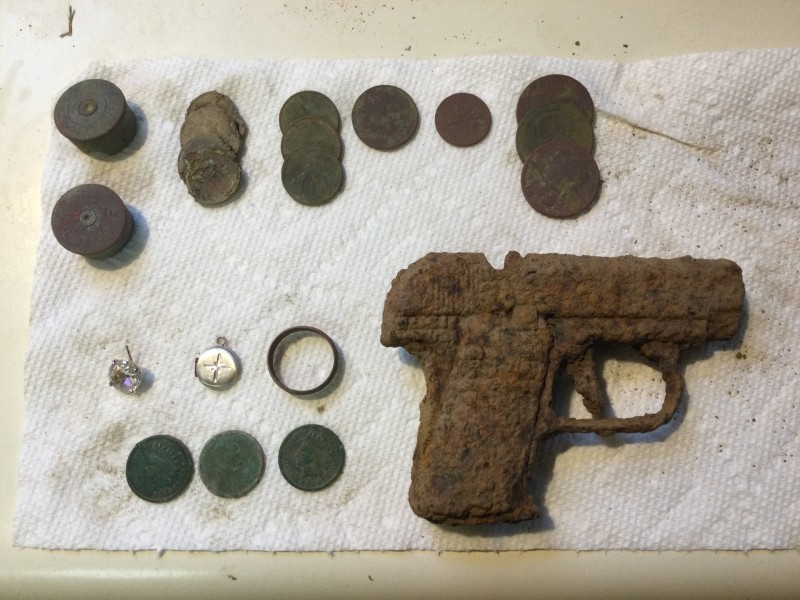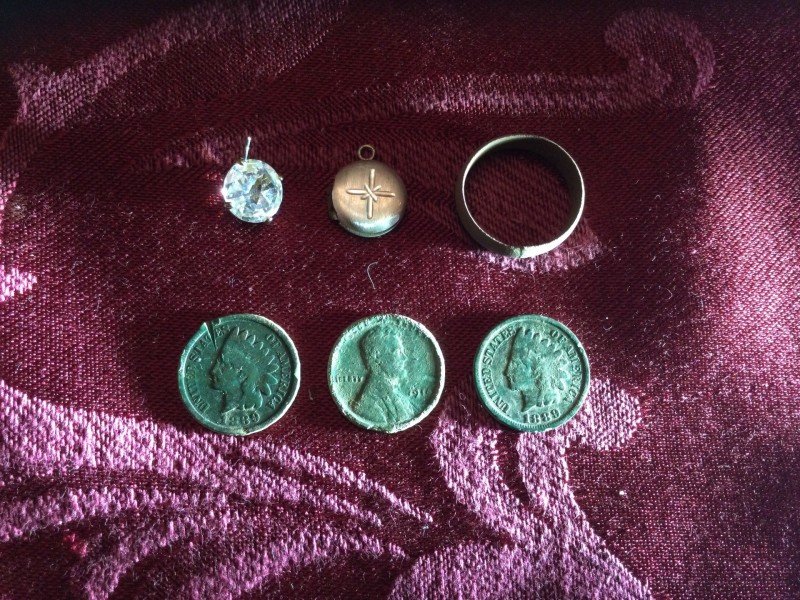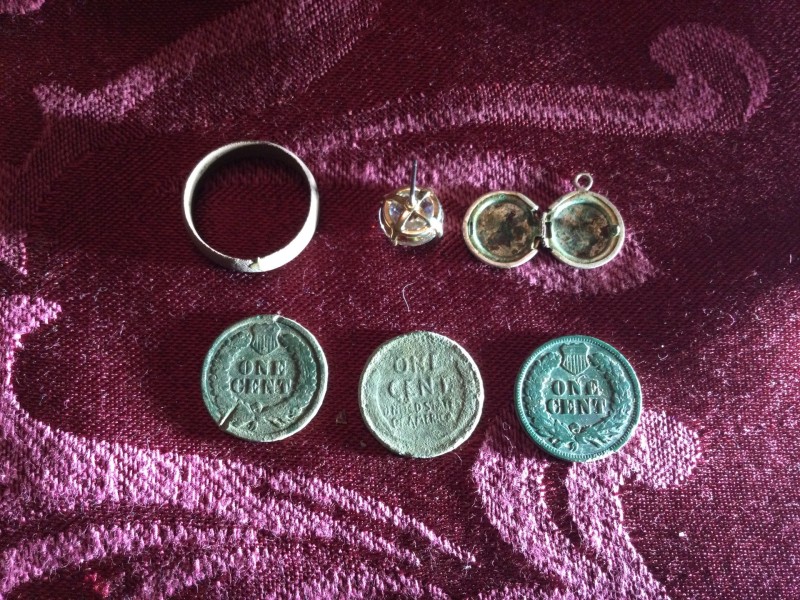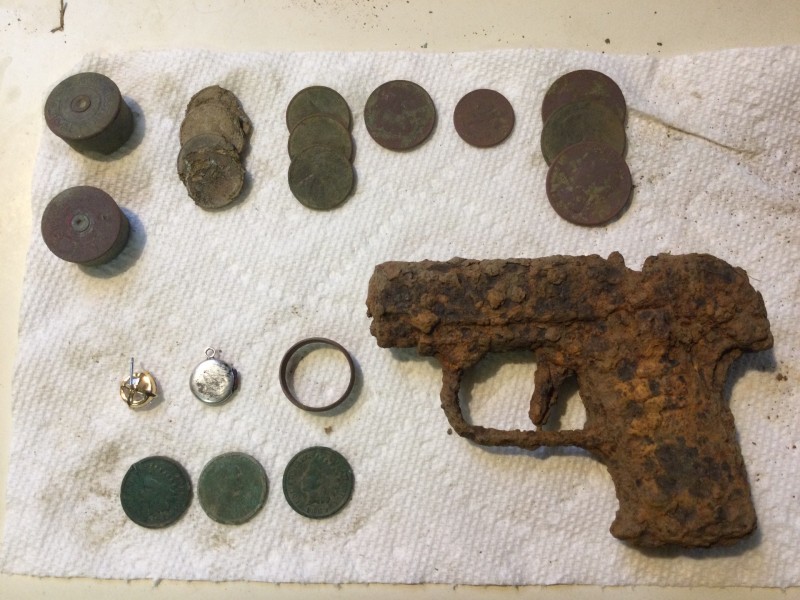-
Posts
331 -
Joined
-
Last visited
Content Type
Forums
Detector Prospector Home
Detector Database
Downloads
Everything posted by Geologyhound
-
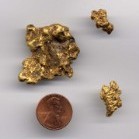
The Jewelry Box (long And Lots Of Pics)
Geologyhound replied to F350Platinum's topic in Metal Detecting For Coins & Relics
It says FFA above the plow and owl. The Future Farmers of America was founded in 1928. Almost every pin I found online also had an eagle perched on top. I only found one without the eagle like yours. That seller at Worthpoint thought it might be a greenhorn pin.- 24 replies
-
- jewelry found
- relic found
-
(and 1 more)
Tagged with:
-

The Jewelry Box (long And Lots Of Pics)
Geologyhound replied to F350Platinum's topic in Metal Detecting For Coins & Relics
That is one cool badge! Days like that really whet your whistle for more. What is the little button/pin on the right side of the picture below the rings? I can see there is some sort of pattern on it but I can’t make out what.- 24 replies
-
- jewelry found
- relic found
-
(and 1 more)
Tagged with:
-

Defense Plant Corp. Tag
Geologyhound replied to Geologyhound's topic in Metal Detecting For Coins & Relics
Ah, so you think this might’ve been on a crate of munitions rather than a piece of equipment? -
I have been digging zinc pennies at this site because I have found several IHPs, and was rewarded with another IHP - 1888. I certainly took a close look at the last eight. Unfortunately I can’t see any trace of a 7 under it. So it is not one of the valuable error coins from that year. ☹️ However, I find the Defense Plant Corp. tag to be rather interesting. The Defense Plant Corp. was a US government corporation from 1940 to 1945 basically in charge of funding war time factories. I wish there was some way of looking up the serial number on the tag to see on what kind of equipment it used to be mounted. Anyone have any ideas on that subject?
-
Thanks! Good to know there are some multi charger options and I don’t have to stick with the original base.
-
Thank you!!
-
I purchased my D2 about a year ago and have just left the charge mains and USB base either plugged into the wall or next to that outlet. I went to charge my detector the other day and found one of my family members had taken the USB base! I vaguely recall the original instructions mentioning all of the markings which needed to be on a proper base to charge XP equipment. So I have always considered the original base as dedicated for my detector. Problem is I never paid attention to it after I got it so I don’t remember what it looked like. Could somebody please post a picture of what their charging base looks like? Also does anyone know whether a standard USB plug-in will work for a charger base for XP equipment? I have attached a picture of the only loose unknown base I have found. I don’t remember it being white and it doesn’t look like the pictures on the XP website. But, I don’t know if all the units are shipped with the black base shown on the XP website. I am just afraid of frying my equipment if I use the wrong charger. So any help is greatly appreciated!
-

Another Relic Id Needed.
Geologyhound replied to Capphd's topic in Metal Detecting For Coins & Relics
Looks convex on one side and concave on the other. The concave side is a different color and cracked like a residue of some sort might still be on it. Could it be a lid for a small jar or vial? Was there any glass, ceramic or other possible container indications when you dug it? -

A Dozen Buttons And A Silver Shock!
Geologyhound replied to F350Platinum's topic in Metal Detecting For Coins & Relics
Looks like yours is the large eight version? Still worth about $1421 in G4 condition (if it were complete and intact ☹️). A great find nonetheless! Maybe it’s sister is hiding out there somewhere… -

Trying To Make Up For Last Year
Geologyhound replied to deathray's topic in Metal Detecting For Coins & Relics
You sure have found some nice spots to detect! -

A Dozen Buttons And A Silver Shock!
Geologyhound replied to F350Platinum's topic in Metal Detecting For Coins & Relics
Nice! I’m glad the legible side has the date. It almost looks like the backside got sheared off rather than worn off. Is it overly thin? -

Looking For Stuff In All The Wrong Places
Geologyhound replied to F350Platinum's topic in Metal Detecting For Coins & Relics
Last metal detecting club meeting someone entered a find in the find the month which was a working (?) 1800’s miniature toy cannon about the diameter of a pencil on a hinged mount something like what you have. Now I wish I’d had more time to take a closer look at it.- 12 replies
-
- coin found
- relic found
-
(and 1 more)
Tagged with:
-

Unknown Macedonian Crystals Help Id!
Geologyhound replied to rockidQ24's topic in Rocks, Minerals, Gems & Geology
The little tiny milky crystals may be drusy quartz. -
Thanks! At 8 ounces it has a completely different heft than any of the cap pistols I have found or owned. Do you happen to know the primary metal used in the Kilgore line? The other cap pistols I have found basically peeled chrome back and the aluminum or tin or whatever underneath rotted away into white powder which left the cap pistols in multiple pieces. This is weakly magnetic all over and is definitely rusting.
-
I am running V2. Especially on the last IHP, I probably wasn’t even getting 20% positive signals. Total weight on the gun appears to be slightly over 8 ounces. At this point in time I would hope nothing could actually fire or ignite, but I’m being careful not to flag myself anyway. I don’t really want to try and clean it if there could be anything live in it.
-
Reading about the success of so many forum members on their first 2024 hunt made me itch to get out myself. So, I took an afternoon before the storm front moved in to go hunt the site where I found three 100+ year old coins and a token during my last couple outings. With my 11x13, I moved further along the crest of the hill from where I had been before. After about 30 minutes I hit a fairly solid 81. About 6 inches down I turned up a solid green IHP (1889). This is the one with the obvious scar around the 11 o’clock position. About one foot away I got a questionable signal with an ascending/descending tone mixed with iron tones, and an occasional 79 thrown in for good measure. If I swung one way, the tone ascended (my tone bins have progressively higher pitches with higher TID’s). Swinging back the other way the tone descended. Turning on the target made it dissolve into iron grunts. I am using a fast-based program based off of Rattlehead’s Silver Slayer program, and bottle caps are set at five. Typically, with this ascending/descending broken tone, I find bottle caps. But, 1 foot away from an IHP, I dug it anyway. Around 7 inches down up popped another green disc. I thought I had another IHP, but after I got it home I found out it is a 1918 wheat. Oddly, all I recovered from that hole was the penny. After recovering the penny, I swung the coil over the hole again and no iron. But, there was a 42 a few inches away. With two old coins, I slowed down and started gridding the area. About 20 feet away I got another questionable signal that was mostly iron tones, but I did get an occasional good tone and a 77 from one direction only and one angle. The backswing and changing angles resulted in iron tones. I have probably passed on many signals like this before. But with the number of 100+ year old coins I found here, and an old coin from the last questionable target, I was game. About 8 inches down, I found the unscarred IHP (another 1889). The pinpointer indicated no other targets in the hole. Just like the wheat, when I swung over the hole again, no signal whatsoever. This has got me wondering how many other IHPs or old wheats I may have missed. My soil is fairly mild - usually no bars to a couple bars. Does anybody know why I would be getting a preponderance of iron tones when there is no iron? My recovery speed was at one. I had varied it up to about 2.5 in iron patches but kept backing it down when the iron thinned out. I can understand a good target on the edge of detection may return sporadic good signals, but not why iffy signals from a lone good target would be largely interpreted as iron. In the same area, I found an old brass ring (83). There is an obvious join on one side. I cannot see any inscription inside or out. A 93 had me hoping for another quarter, but I am happier with the little silver locket. I dug too deep for that and had to break apart the plug to find it (the pinpointer missed it initially). The brass hinge has seen better days. When it opened, the hinge came apart. There is nothing inside anymore. Late in the day I got a solid 61. Thinking nickel, I again dug too deep. I was rewarded with the earring. This was about 3 inches down and is completely free of corrosion. It is also relatively heavy. I don’t have any metal or stone test kits/instruments. I was figuring glass or CZ, but I took it by a local jewelry shop. The guy took a look at it and said he figures it’s glass, but he did not test it. He said it is faceted wrong for diamond or CZ. ☹️ There appears to be a slight lightening of shade on the tip of the prongs. This makes me wonder if they are plated. There is no mark that I can see. The manufacture date on the Winchester Blue Rival No 12 dates from 1894 to 1904. The manufacture date on the Peters Target No 12 dates from 1902 to 1911. So, this is the second time I have found three 100+ year old coins in one day at this site. It is also the first time I’ve ever found two IHPs in one day. Combined with the jewelry, I was very pleased with my first day out for 2024! However, the oddest find of the day was the little palm pistol. It is 4.25x3x1 inches, and is too heavy to be a cap pistol. It is hard to tell with the rust, but the muzzle opening appears to be about 3/16 inch. The whole thing is pretty well caked in rust including the grip. Does anybody have any idea either how to clean it, or what it could be? I don’t know about anyone else but I am looking forward to many more good finds in 2024. Happy hunting everyone!
-
Jackpot!!! Stake a claim - that is a gold mine!
-

First Hunt Of 2024 - Tale Of (g)old
Geologyhound replied to F350Platinum's topic in Metal Detecting For Jewelry
Just the gold ring is a great find, but the inscription to go with it must have left you in shock! With a 300 year-old ring, there must be other stuff there older than zincolns… -
That is a great start to the year in my book!
-

When Your Wife Tells You To Go Detecting, Just Go!
Geologyhound replied to CPT_GhostLight's topic in XP Deus II Forum
🎉 Hooray!! Fantastic way of breaking in your new coil! I hope your wife got a good night out. 😄 -
A belated Christmas present, but one you are glad to accept! Now for the next one…. Has you hooked doesn’t it?😁
-

Last Hunt Of The Season #4
Geologyhound replied to F350Platinum's topic in Metal Detecting For Coins & Relics
Glad you felt up to swinging the 13”! Out of curiosity, how do you prefer your equalizer settings? Good luck on your last last hunt of 2023 Sunday afternoon… 😄 -

Some Recent Finds I Cleaned
Geologyhound replied to Geologyhound's topic in Metal Detecting For Coins & Relics
You probably can. I certainly had never done it until now. This was my first night. -

Some Recent Finds I Cleaned
Geologyhound replied to Geologyhound's topic in Metal Detecting For Coins & Relics
The set of crayons I used was about $25 online (but note I am not showing a vendor in the picture as I don’t want to run afoul of any advertising restrictions). Generally, I used the white fiberglass tip in small circles in an area that appeared to be devoid of any pattern. I would keep checking with a different angle of light but keep “digging“ a “test pit” until I could just start to see darker lines through the tan dust. Then I would switch to the harder, than the softer black tip until I could clean up the actual surface. I figure the white is probably “coarse“, the harder black is probably “medium” and the softer black is “fine“. After that, I would dust it off with the steel wool tool. At that point in time I knew how deep the surface of the coin was. I then started to work out from there and encompass areas which might have details. Once I had each area surrounded, I would start to work my way in by very gently rubbing across the top (first with the white tip then later with one of the two black tips) to remove a layer of cemented dirt, dust it off with the steel wool tool, then check it for any possible pattern showing through. As text would start to emerge, I would tighten up the perimeter to define the top and bottom of the letters/pattern and then work my way down until I could start making out individual letters (even if I couldn’t make out what the letters were). After successive rounds of this, letters would start to become more evident. I could then clean up around each letter with the soft black tip and dust it off with the steel wool tool. I used the soft black tip to clean up the details on the head. Basically, it appears to be harder than the dirt but softer than the surface of the coin as long as you don’t push too hard on a fragile patina. So when the head was exposed, I just scribbled in small circles across the whole head, and concentrated in areas where a bunch of tan dust would start to accumulate. Areas between the writing and the rim were too narrow for circles so I just went back-and-forth in a trench until I could just start to see the surface of the coin and then proceeded as above. I imagine soil conditions and hardness of cementation vary by location. So results may vary. I strongly suspect the coins need to be dry (and the patina hardened up) for a couple days before working on it. These had dried for a couple days. As I mentioned in the original post, when I scrubbed the coins with a soft bristle toothbrush and water right after getting them home trying to find a date, part of the rim flaked off. I have to wonder if it would’ve sloughed off anyway. But I don’t know at this point. My practice pennies did show if you take off the patina and expose the pitted metal surface you have gone too far. That seems to be softer, and details can vanish if you are not careful. This was another reason for my “test pits“ in areas without details. This would give me a feel for how much pressure the surface could take. As with any tedious activity, it requires a certain amount of patience and restraint. Don’t go too fast. You have to be willing to put it down and come back to it. Work in a location with good lights, a magnifying glass may help, and you’ll probably get a kink in your neck... But seeing the difference in these made it all worthwhile to me. At least these are my observations based on one night’s work. As such, I would not classify myself as an expert in the matter…


